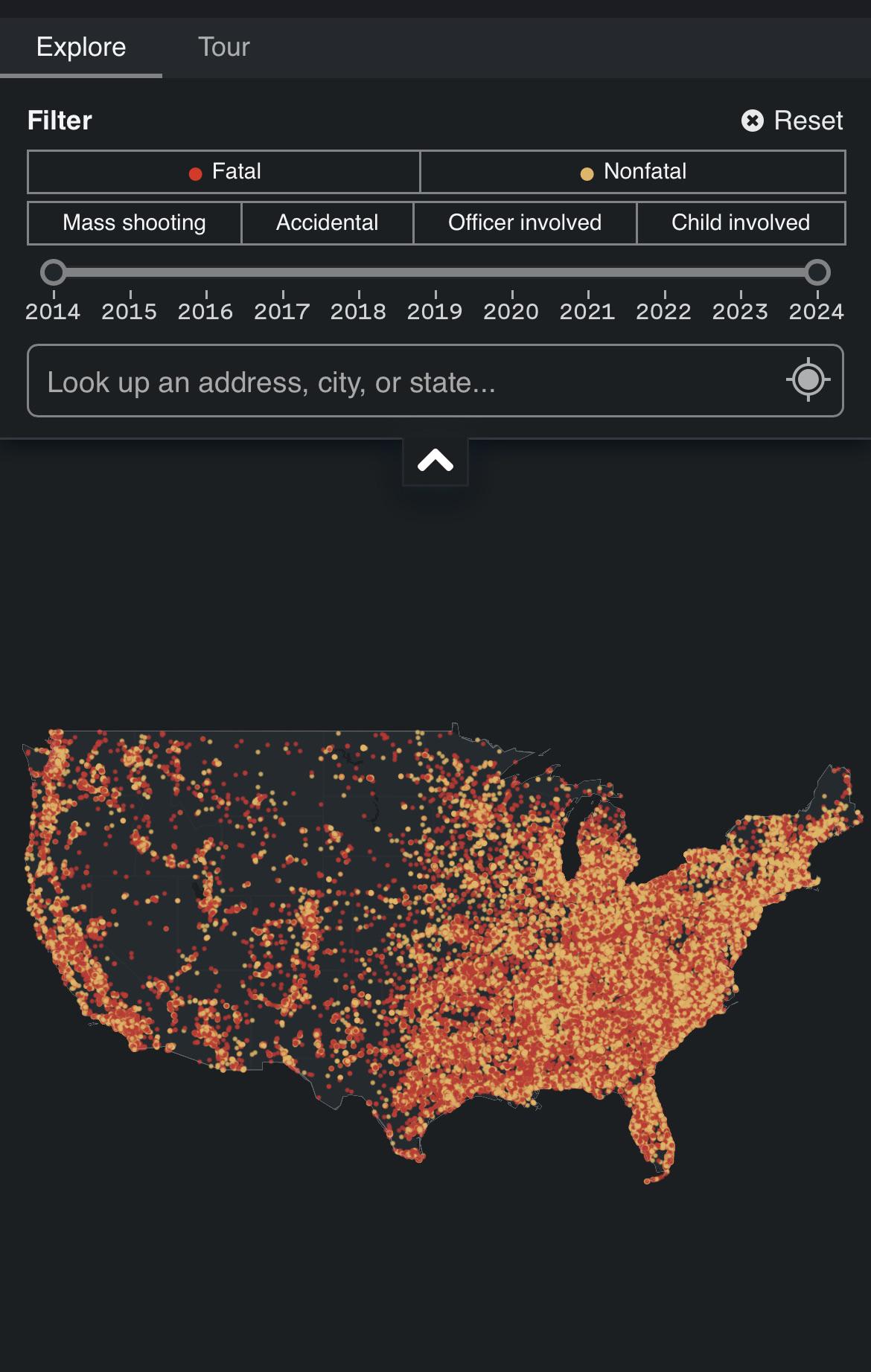Gun Violence Map of America


David Chen
Data Visualization Specialist
David Chen is an expert in transforming complex geographic datasets into compelling visual narratives. He combines his background in computer science ...
Geographic Analysis
What This Map Shows
The "Interactive Atlas of American Gun Violence" provides a detailed visualization of shootings across the United States, highlighting both fatal and non-fatal incidents. This informative map allows users to explore various aspects of gun violence in specific regions, offering a stark representation of a critical issue that impacts communities nationwide. By displaying data on shootings, the map serves as a crucial tool for understanding the patterns and trends of gun violence in America.
Deep Dive into Gun Violence in America
Gun violence in the United States is a multifaceted issue that has profound social, economic, and political implications. According to the Gun Violence Archive, more than 40,000 gun-related deaths occurred in the U.S. in 2021 alone, with a staggering number of those being homicides. Interestingly, the statistics reveal that gun violence is not distributed evenly across the country. Urban areas often experience higher rates of gun violence compared to rural regions, though rural communities are not immune to this crisis.
One of the driving factors behind the prevalence of gun violence is the accessibility of firearms. The U.S. has one of the highest rates of gun ownership in the world, with an estimated 393 million civilian-owned guns, which equates to about 120 guns for every 100 residents. This easy access to firearms correlates with higher rates of gun violence. Moreover, socio-economic factors, such as poverty, unemployment, and lack of educational opportunities, contribute to the cycle of violence.
Moreover, mental health issues cannot be overlooked. Many shooters have histories of untreated mental health problems, which, when combined with access to firearms, can lead to tragic outcomes. The conversation around gun violence is often polarized, with advocates on both sides debating the balance between Second Amendment rights and the need for comprehensive gun control measures. Understanding the geography of gun violence can help policymakers address the root causes effectively.
What’s fascinating is the variation in gun violence rates across different demographics. For example, young males, particularly those aged 15-34, are disproportionately affected by gun violence, often as both victims and perpetrators. Racial disparities are also evident, with Black Americans facing an alarmingly higher risk of gun homicide compared to their white counterparts.
Regional Analysis
When looking at the map, it’s clear that gun violence tends to cluster in specific regions. For example, cities like Chicago, Baltimore, and New Orleans consistently show high rates of gun-related incidents. In Chicago, for instance, a combination of gang violence, socio-economic disparities, and community disinvestment has led to a dramatic rise in shootings and homicides.
In contrast, states like Vermont and New Hampshire report some of the lowest rates of gun violence in the country. This can be attributed to a combination of factors, including lower population density, higher median income levels, and strong community ties. Interestingly, even states with high gun ownership, such as Alaska and Montana, experience lower rates of gun violence, suggesting that factors such as community engagement and socio-economic stability play crucial roles.
Furthermore, while urban areas face significant challenges with gun violence, rural communities are increasingly experiencing incidents, though often in different contexts, such as domestic violence or suicides. In states like Wyoming and West Virginia, gun-related deaths are alarming, primarily driven by suicides rather than homicides. This highlights the need for targeted interventions that address both mental health issues and the accessibility of firearms.
Significance and Impact
Understanding gun violence is essential for multiple reasons. It shapes public policy, impacts community safety, and influences the national conversation around gun rights and regulations. The implications of gun violence extend beyond immediate physical harm; they affect community cohesion, economic stability, and public health.
Moreover, as society continues to grapple with the implications of gun violence, trends indicate that without intervention, the issue may worsen. The rise of mass shootings has particularly captured public attention, leading to calls for stricter gun control measures, yet the political landscape remains divided. Addressing gun violence requires a comprehensive approach, integrating law enforcement, community programs, and mental health resources.
In conclusion, the "Interactive Atlas of American Gun Violence" not only provides a visualization of this pressing issue but also serves as a catalyst for discussion and action. As we continue to analyze the data and trends, it’s crucial for communities, policymakers, and individuals to engage with this information to drive meaningful change and promote safety for all Americans.
Visualization Details
- Published
- September 29, 2025
- Views
- 36
Comments
Loading comments...